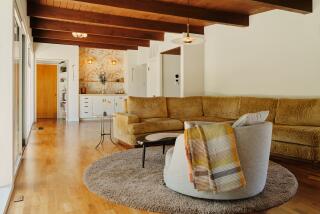Steeling Beauty
- Share via
When Austrian artist Hubert Schmalix moved to Los Angeles in the late ‘80s with his wife, Fresnaida, and their two young daughters, he took up residence in Mt. Washington, one of the city’s oldest neighborhoods. There Schmalix fell in love with the sweeping views and the bohemian quality of the area, a favorite among artists, writers and architects since the early 1900s. “I love the neighborhood’s diversity,” he says. “From a distance the houses look very anonymous, but when you look closer and see their gardens or the individual colors they are painted, you realize each house has a very personal character. I wanted to make this place our home.”
Schmalix serendipitously found the perfect lot during an afternoon drive five years ago. He called in L.A. architects Alice Fung and Michael Blatt of Fung + Blatt to design the home. “He had a simple list of criteria,” recalls Fung. “He wanted a painting studio, three bedrooms, high ceilings and a lap pool. Then he just let us go.”
For the record:
12:00 a.m. Aug. 12, 2001 For the Record
Los Angeles Times Sunday August 12, 2001 Home Edition Los Angeles Times Magazine Page 6 Times Magazine Desk 1 inches; 34 words Type of Material: Correction
In “Steeling Beauty” (Style, June 24), it was incorrectly reported that the recycled concrete used for the patio at the home of artist Hubert Schmalix came from a demolished gas station. It came from the San Rafael Drive retaining wall project.
The team created a lavender-hued steel-framed home that is a 110-foot-long lyrical composition in three parts. The north side, with its distinctive saw-tooth roof line and north-facing clerestory windows, houses Schmalix’s 1,100-square-foot studio. To the south, a Quonset hut structure of corrugated steel wraps around an upstairs study and extends over an open two-story-high living room. A carport bridges the two structures and allows passersby to see through to the hillside, which is covered with toyon and black walnut trees, sage and other chaparral.
To keep costs as low as possible, Fung and Blatt opted for a simple palette of generic industrial materials that required little finishing. Steel, concrete and galvanized sheet metal are used both inside and out, while massive bare concrete foundation walls are left exposed. In the kitchen and long hallway and bedrooms, board-formed concrete was left in its raw state. “We like how it looks--the honesty of it. And it’s cost efficient because you don’t have to come back and cover it up with another layer,” says Blatt.
In addition, the house’s frame is entirely light- and heavy-gauge steel, unusual in residential building. “Steel is straighter and stronger than wood, which allows for taller walls and longer spans, such as the 16- and 22-foot-high ceilings in the studio and living room,” Blatt explains. “But you don’t have the waste with it since you order everything cut to size, ready to fit together.”
Fiber cement panels, composed of cement and recycled newspapers, clad the exterior, which they painted with an epoxy-based finish that doesn’t flake or chip and ages and fades with the material. In collaboration with Schmalix, they chose a grayish-purple hue for the exterior, the color of the sword-shaped pride of Madeira that grows on the hillside.
Inside, the Schmalixes’ furnishings are a casual mix of modern and vintage pieces: Italian modern sofas, a 1950s Danish dining set, a pair of Biedermeier chairs from the artist’s grandmother. Their collections of art, pottery, ethnic jewelry and Moroccan Berber rugs infuse the house with the couple’s colorful personal style. “It’s evolving,” says the artist, who continues to add individual touches, such as the floor-to-ceiling mural he painted in the living room and the 400 pounds of glass beads from Czechoslovakia that he and his family hand-strung to enclose a storage area. A smaller personal flourish is found in the master bathroom, where he hung floral wallpaper. “Putting up a traditional wallpaper is something you don’t do in a modern house,” says Schmalix, who was a member of Austria’s “wild” group of late-Modern painters, “so it seemed like a good idea. The house needed a bit of humor.”
The artist is also a firm believer in moving things around. The Berber carpet in the living room, one of 22 the couple own, changes weekly. Displays from their collection of glazed art pottery continually rotate. “I sometimes put them all away and just leave one piece out. Then I’ll put that one away and put three others there,” says Schmalix. Recently he hung a large painting over his living room mural. “If you don’t change things, you end up not seeing them after a while,” he says. Houses, like paintings, are all about evolution.


